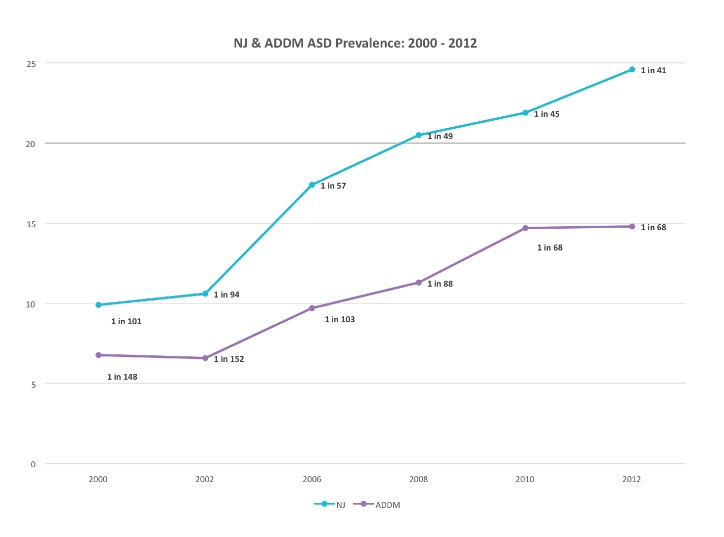Concerns over quality of survey methodology and inadequate government response to autism epidemic continue
The Centers for Disease Control and Prevention (CDC) today released data on autism prevalence from its most recent survey. The report, “Prevalence and Characteristics of Autism Spectrum Disorder Among Children Aged 8 Years — Autism and Developmental Disabilities Monitoring Network, 11 Sites, United States, 2012” (1) found 1 in 68 eight year olds in the U.S. to have an autism spectrum disorder. These children would have been born in 2004. The 1 in 68 figure is the same 1 in 68 prevalence reported in the previous 2010 CDC survey of 2002 births, indicating a flattening in the huge upward trend noted from earlier surveys since the 1990’s births, when autism was 1 in 294.
The flattening in prevalence occurred across subgroups, including those with Intellectual Disability and those with average to above average IQ’s, and by girls and by boys. Thus, despite enormous awareness campaigns which may have increased identification of those with milder autism symptoms (generally co-occurring with normal IQ) and which have focused on under ascertainment of girls, these subgroups did not increase, per the CDC. It should be noted that the rate of Intellectual Disability in this and the previous 2010 report reflects a slight drop in co-occurring ID from pre-2010 reports.

New Jersey Medical School
The state with the highest prevalence was New Jersey. New Jersey has kept the most rigorous and consistent case ascertainment practices since being included in the CDC survey. New Jersey continues to see a significant increase in prevalence, rising 12% in two years, from 1 in 45 in the 2010 report to 1 in 41 in this latest report.
The CDC chronically underestimates the rate of autism in its surveillance studies. It includes sites which only collect medical records rather than both medical records and education records. Medical records miss a high percentage of autism cases: 17.1 per 1000 are ascertained using both sources, versus only 10.7 per 1000 for medical records alone. The case ascertainment methodology is also subject to alarming variability depending on the cachement area selected, how a site can access records, how medical records are kept, and the quality of the investigators assigned to a site.
“The CDC refuses to change its practices despite years of criticism by SafeMinds and others,” said Sallie Bernard, SafeMinds board president. “We need better epidemiology if we are to scientifically understand the magnitude, causes and composition of the autism epidemic. For example, if we can have confidence that the rate is stabilizing, we can identify what exposures in the environment might have increased from 1990 to 2002, creating the huge rise in cases among those birth cohorts, which then stopped increasing from 2002 to 2004.”
The time to diagnosis is also concerning. While the vast majority (87%) had indications of developmental concerns before age 3, less than half (43%) had received a comprehensive evaluation, with the median age of evaluation 40 months, a number which hasn’t changed over the survey years. Non-white children continue to be under ascertained and evaluated at later ages, missing critical time windows for intervention. Early diagnosis and intensive specialized therapy are proven to improve outcomes in many children with autism.
“The government and our health care systems continue to fall short when it comes to delivery of the most basic services which are critical to optimal outcomes for children on the autism spectrum,” said Lisa Wiederlight, executive director of SafeMinds. “We need national policies that address the urgent needs of the autism community. Autism costs U.S. taxpayers $268 billion per year, and our government’s response is grossly inadequate.”
(1) Deborah L. Christensen, PhD, Jon Baio, EdS, Kim Van Naarden Braun, et al. Prevalence and Characteristics of Autism Spectrum Disorder Among Children Aged 8 Years — Autism and Developmental Disabilities Monitoring Network, 11 Sites, United States, 2012. CDC. Morbidity and Mortality Weekly Report Surveillance Summaries / Vol. 65 / No. 3 April 1, 2016. http://www.cdc.gov/mmwr/preview/mmwrhtml/ss6302a1.htm


